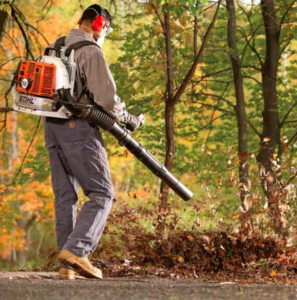Emissions
Gas-powered leaf blowers emit harmful toxins, contributing to air pollution.
Noise
Gas-powered leaf blowers can produce noise that exceeds 90 decibels, damaging our hearing and disrupting wildlife habitats.
environmental Harm
Removing leaves depletes the soil of essential nutrients and compromises biodiversity.


You may have a clean yard, but the air is toxic!
Gas leaf blower engines, though small, can release harmful emissions like carbon monoxide, nitrogen oxides, and toxic hydrocarbons. Using a gas leaf blower for one hour can cause as much air pollution as driving a car over 1500 kilometres.
fUEL COMBUSTION
Two-stroke motor gas leaf blowers are commonly used. The unburned fuel from these machines spews toxins like benzene and formaldehyde and ultrafine particles.
wHAT DOES THIS MEAN FOR US?
The poor air quality due to emissions can cause respiratory issues like allergies and worsen asthma. The toxic hydrocarbons from incomplete combustion are known carcinogens that are linked to cancer and other serious health issues.
Beyond harmful gases, gas blowers cause noise pollution that can exceed safe levels. The high decibel noise can cause stress, mental health issues, and hearing problems.
Multiple hours of use of gas leaf blowers across numerous households can harm more than our neighborhood. They can accelerate climate change and global warming as they emit carbon dioxide, a potent greenhouse gas.
REFERENCES
- Small Engine Fact Sheet
- Watkins, R. G. (2019). Particulate Matter (PM) and Ultrafine Particle (UFP) Measured on Pedestrian Walkways During and After the Nearby Use of Leaf Blowers (Order No. 22621758).

You may have a tidy lawn, but a damaged environment!
We may aspire for a clean looking lawn, but with the leaves, we are also blowing away the natural processes that can enrich our lawn. Leaves, if left on the lawn, can be a source of natural organic matter, replacing the soil with essential nutrients like nitrogen, phosphorous, and potassium.
not just about the plants
While blowing the leaves away, we are also removing the tiny creatures like the worms, insects, and other invertebrates. These creatures contribute more to our ecosystem for their free stay on our lawn. Clearing the leaves deprives beetles, spiders, and caterpillars of their shelter and food. Removing the leaves also disrupts the habitat and life cycle of the friendly pollinators like butterflies, bees, and moths. If they are all wiped clean, then predators like birds and larger animals are left with no food. Clean yards come at the cost of disturbing the food chain, using our not-so-cheap lawn toys.
wHAT DOES THIS MEAN FOR US?
A green-enriched lawn and a thriving flower bed in the summer starts with leaving the leaf litter during fall and winter—it is as simple as that! It leaves a vibrant, self thriving ecosystem in our lawn.
On the other hand, a clean lawn does not support a clean climate later, as it breaks the ecosystem, harms biodiversity, and presents a less supportive, resilient environment. In short, we would spend money and effort towards detrimental effects on ecosystem biodiversity, thereby causing climate shifts from our very own lawn.

You may have a spotless lawn, but also ringing ears!
Gas leaf blowers, depending on the model, can exceed noise levels of more than 90 dB, which is higher than safe levels for human hearing. The World Health Organization (WHO) and Health Canada suggest that noise levels above 70 dB can affect quality of life and pose hearing damage risks.
wHAT DOES THIS MEAN FOR US?
Prolonged exposure to such high noise levels can cause hearing damage. Regular exposure to noise can also cause high blood pressure and sleep issues. Research shows that higher noise levels can adversely affect heart health, especially in children and the elderly.
If leaf blowers are perceived as loud by us, imagine how much it can disrupt the wildlife. This can adversely impact the biodiversity and local ecosystem, interfering with wildlife feeding, nesting, and communication patterns.
rEPORTING HIGH NOISE LEVELS
London’s Sound Bylaw regulates excessive or unusual noise distressing the peace of a neighborhood. Persistent or excessive noise that occurs outside of allowed hours will violate the bylaw. To file a complaint, contact the city through email: enforcement@london.ca. You may record the noise to account for the details of the nature and frequency of the noise.
REFERENCES
-
- Compendium of WHO and other UN guidance on health and environment
- Guidance for Evaluating Human Health Impacts in Environmental Assessment: NOISE
- Mehrotra, Anupam; Shukla, Sheo Prasad; Shukla, A.K.; Manar, Manish K.; Singh, S.K.; Mehrotra, Monica. A Comprehensive Review of Auditory and Non-Auditory Effects of Noise on Human Health. Noise & Health 26(121):p 59-69, April-June 2024. DOI: 10.4103/nah.nah_124_23

